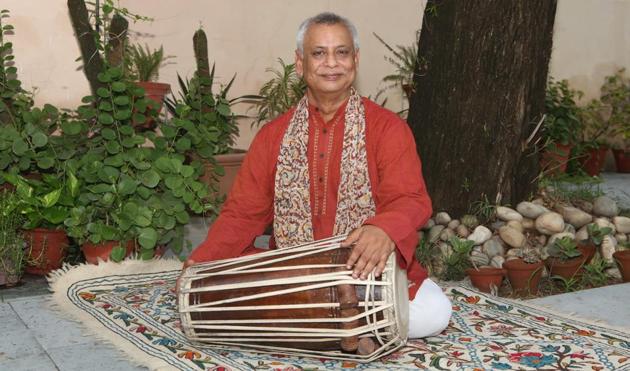Pakhawaj patronage: Meet this doctor and his instrument, that’s one of the oldest on Earth
Pakhawaj player Dr Anil Chaudhury says it’s important for Indian classical music to be promoted among the common masses, for it to grow and blossom.
As droplets of water fall from the sky, the soothing music emanating from the pakhawaj being played by Dr Anil Chaudhury — in the green environs of his house garden in central Delhi — touch the soul. One is fortunate to witness this private rendition by the 64-year-old ophthalmologist, who has been learning the percussion since the age of six, and is one of the very few pakhawaj players in the country, today.

“Pakhawaj is one of our oldest rhythm instruments. Its mention is also found in the Ramayana and the Mahabharata. Remember the part when Ramachandra ji enters Lanka and is about to attack Ravana but feels threatened by his powers just a night before the attack because he hears thunderous noises? That’s when Vibhishana reveals to him that it’s Ravana playing the Shiva Tandava,” says Chaudhury.
Ask him about the time when he started playing Pakhawaj and childhood memories come rushing back to him. “I still remember vividly… My nana (maternal grandfather father) Pt Yamuna Prasad Chaudhary, a zamindar, was a pupil of Baba Thakur Das – who was connected to Ayodhya, one of the prominent centres of Pakhawaj. The moment he finished his riyaz (practice), and left for work, I used to enter the room, sit in the same position like him, and play pakhawaj as if trying to copy him. One day, baba (his nana) heard me playing, and asked my maternal grandmother if he should train me? After getting permission, he started my training. The first lesson was of course the knowledge of how sound comes out, that is, thaap.”
Chaudhury confesses that he was fortunate to find a guru in his father, and was able to learn while living in the comfort of his house. “But, it was my bad luck that I didn’t take my training seriously. Whatever he taught me, it was his blessing, not my ability to grab. Baba had limitless knowledge; had I learnt even 70 per cent of what he knew, I wouldn’t have felt the remorse today,” he says adding that it was also the ambience around him that distracted him to develop a career in the medical field. “I took admission in Patna’s Nalanda Medical College, completed my education and took up work in Delhi’s Dr Ram Manohar Lohia Hospital in 1983. Around the same time my father passed away,” he says.
READ | Sonal Mansingh on Rajya Sabha nomination: I didn’t think if it should have come earlier
“Given a chance to reconsider my decision, I would decide to become a full-time artist,” says the practising doctor who feels that today’s generation is much more empowered to opt for a career of their choice. He adds, “I later pursued training in pakhawaj from Pt Ram Ashish Pathak (doyen of pakhawaj) — one of my baba’s contemporaries — but till date I consider myself as a student of pakhawaj. The young artists learning pakhawaj today don’t have to face the challenges that one had back then; but their knowledge isn’t as deep either. Earlier the Indian classical artists were protected by the kings and even tawaif (sophisticated courtesan) gharanas, which allowed the artists the freedom to practice. And, the students didn’t perform till the time their gurus were fully satisfied with their acquired skills, unlike today where the youngsters learn 2-3 things and rush to venture on the stage to perform. But, the negative aspect is that since Indian classical arts remained exclusive to the kingly courts, the common public couldn’t familiarise or appreciate it.”
The artist is happy that the boundaries associated with Indian classical music are becoming malleable. “A lot of girls are playing pakhawaj today, and are playing well. That’s because they have been imparted the technique. Earlier pakhawaj was considered a man’s music instrument, but that no longer holds true. And it’s a positive step because till the time the knowledge of playing Indian musical instruments reaches a wider audience, it won’t grow,” he says.
READ | Amaan-Ayaan refuse ‘yuva’ award; Sangeet Natak Akademi says an artist is young at 40
But, he rues that the few and rare mediums to promote Indian classical music — radio and TV — aren’t being exploited to the fullest. “There are just one or two artists in All India Radio, which used to earlier air regular performances by senior artists of Indian classical music. This is because the main administrators handling radio don’t know about Indian classical music; they are bureaucrats. Also, there’s no government university to gain training in pure Indian classical music. So, when we talk about conserving our culture and tradition then it should also include Indian classical music because no country can progress without safeguarding its literature, arts, education and health.”
Interact with the author at Twitter/@HennaRakheja






